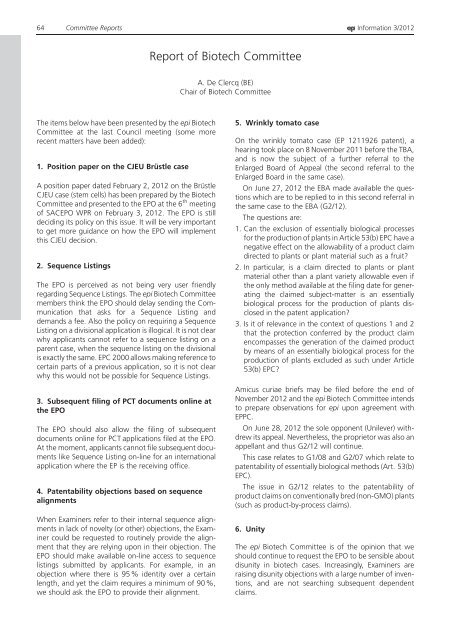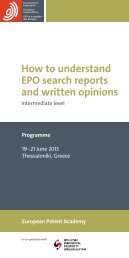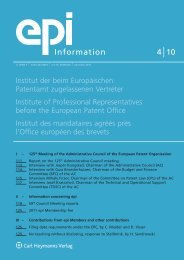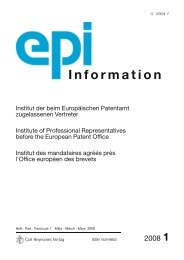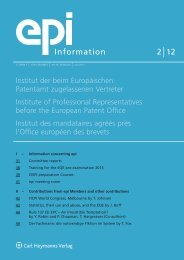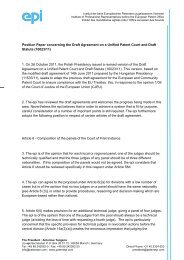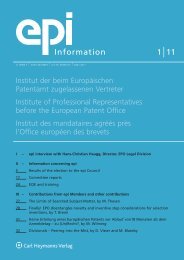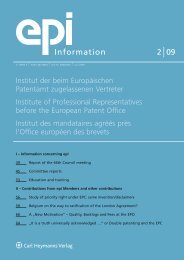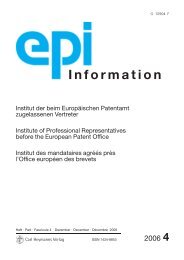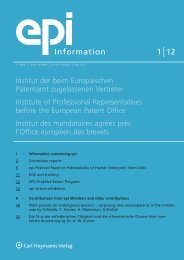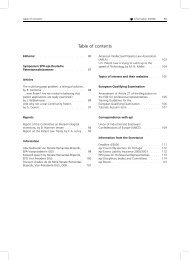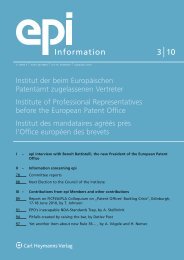Create successful ePaper yourself
Turn your PDF publications into a flip-book with our unique Google optimized e-Paper software.
64 Committee Reports Information 3/2012<br />
The items below have been presented by the <strong>epi</strong> Biotech<br />
Committee at the last Council meeting (some more<br />
recent matters have been added):<br />
1. Position paper on the CJEU Brüstle case<br />
A position paper dated February 2, 2012 on the Brüstle<br />
CJEU case (stem cells) has been prepared by the Biotech<br />
Committee and presented to the EPO at the 6 th meeting<br />
of SACEPO WPR on February 3, 2012. The EPO is still<br />
deciding its policy on this issue. It will be very important<br />
to get more guidance on how the EPO will implement<br />
this CJEU decision.<br />
2. Sequence Listings<br />
The EPO is perceived as not being very user friendly<br />
regarding Sequence Listings. The <strong>epi</strong> Biotech Committee<br />
members think the EPO should delay sending the Communication<br />
that asks for a Sequence Listing and<br />
demands a fee. Also the policy on requiring a Sequence<br />
Listing on a divisional application is illogical. It is not clear<br />
why applicants cannot refer to a sequence listing on a<br />
parent case, when the sequence listing on the divisional<br />
is exactly the same. EPC 2000 allows making reference to<br />
certain parts of a previous application, so it is not clear<br />
why this would not be possible for Sequence Listings.<br />
3. Subsequent filing of PCT documents online at<br />
the EPO<br />
The EPO should also allow the filing of subsequent<br />
documents online for PCT applications filed at the EPO.<br />
At the moment, applicants cannot file subsequent documents<br />
like Sequence Listing on-line for an international<br />
application where the EP is the receiving office.<br />
4. <strong>Patent</strong>ability objections based on sequence<br />
alignments<br />
When Examiners refer to their internal sequence alignments<br />
in lack of novelty (or other) objections, the Examiner<br />
could be requested to routinely provide the alignment<br />
that they are relying upon in their objection. The<br />
EPO should make available on-line access to sequence<br />
listings submitted by applicants. For example, in an<br />
objection where there is 95% identity over a certain<br />
length, and yet the claim requires a minimum of 90%,<br />
we should ask the EPO to provide their alignment.<br />
Report of Biotech Committee<br />
A. De Clercq (BE)<br />
Chair of Biotech Committee<br />
5. Wrinkly tomato case<br />
On the wrinkly tomato case (EP 1211926 patent), a<br />
hearing took place on 8 November 2011 before the TBA,<br />
and is now the subject of a further referral to the<br />
Enlarged Board of Appeal (the second referral to the<br />
Enlarged Board in the same case).<br />
On June 27, 2012 the EBA made available the questions<br />
which are to be replied to in this second referral in<br />
the same case to the EBA (G2/12).<br />
The questions are:<br />
1. Can the exclusion of essentially biological processes<br />
for the production of plants in Article 53(b) EPC have a<br />
negative effect on the allowability of a product claim<br />
directed to plants or plant material such as a fruit?<br />
2. In particular, is a claim directed to plants or plant<br />
material other than a plant variety allowable even if<br />
the only method available at the filing date for generating<br />
the claimed subject-matter is an essentially<br />
biological process for the production of plants disclosed<br />
in the patent application?<br />
3. Is it of relevance in the context of questions 1 and 2<br />
that the protection conferred by the product claim<br />
encompasses the generation of the claimed product<br />
by means of an essentially biological process for the<br />
production of plants excluded as such under Article<br />
53(b) EPC?<br />
Amicus curiae briefs may be filed before the end of<br />
November 2012 and the <strong>epi</strong> Biotech Committee intends<br />
to prepare observations for <strong>epi</strong> upon agreement with<br />
EPPC.<br />
On June 28, 2012 the sole opponent (Unilever) withdrew<br />
its appeal. Nevertheless, the proprietor was also an<br />
appellant and thus G2/12 will continue.<br />
This case relates to G1/08 and G2/07 which relate to<br />
patentability of essentially biological methods (Art. 53(b)<br />
EPC).<br />
The issue in G2/12 relates to the patentability of<br />
product claims on conventionally bred (non-GMO) plants<br />
(such as product-by-process claims).<br />
6. Unity<br />
The <strong>epi</strong> Biotech Committee is of the opinion that we<br />
should continue to request the EPO to be sensible about<br />
disunity in biotech cases. Increasingly, Examiners are<br />
raising disunity objections with a large number of inventions,<br />
and are not searching subsequent dependent<br />
claims.


